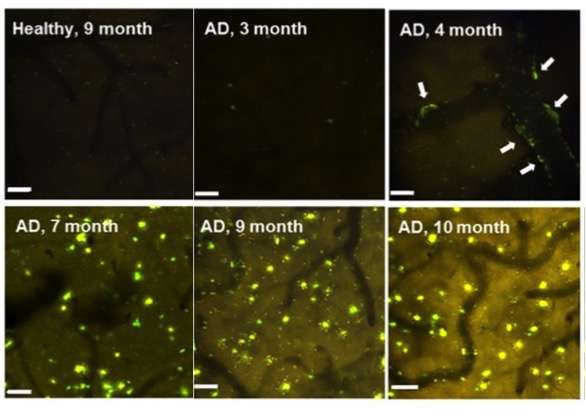MAO is a possible Alzheimer's disease biomarker

Alzheimer's disease affects more than 35 million people, a number that is expected to increase in the coming years. Currently, Alzheimer's diagnoses rely on clinical neuropathologic assessment of amyloid-β (Aβ) peptide aggregates (plaques) and neurofibrillary tangles. But in ACS Central Science, researchers reveal that an enzyme already implicated in a host of neural disorders could someday serve as a biomarker.
In the brains of patients with Alzheimer's, amyloid peptides aggregate to form oligomers and plaques that are thought to be responsible for the disease symptoms. It is difficult to monitor Aβ aggregation in living animals and patients, and current methods to track it in patient brains are costly, have low resolution or require radiation. Monoamine oxidase (MAO) is involved in many neurological disorders, such as depression. In addition, MAO is known to be associated with Alzheimer's, but studies establishing this relationship were only conducted in lab dishes and test tubes. To better understand MAO's association with Alzheimer's, and to determine whether MAO levels could be used as a biomarker for the disease, Inhee Mook-Jung, Kyo Han Ahn and colleagues took the next step and studied the protein in a mouse model of Alzheimer's.
The team devised an imaging tool to watch both Aβ and MAO at the same time in mice, and observed that as Aβ plaques increase (that is, as Alzheimer's progresses), MAO activity also increases. The team also showed that there are three distinct phases of MAO activity that change along with Alzheimer's progression: a slow initiation stage, a subsequent aggressive stage and finally a saturation stage. The authors say these results suggest that MAO could be helpful as a biomarker to someday diagnose and monitor the disease in patients, possibly using body fluids.
More information: Dokyoung Kim et al. Close Correlation of Monoamine Oxidase Activity with Progress of Alzheimer's Disease in Mice, Observed byTwo-Photon Imaging, ACS Central Science (2016). DOI: 10.1021/acscentsci.6b00309
Abstract
Monoamine oxidases (MAOs) play an important role in Alzheimer's disease (AD) pathology. We report in vivo comonitoring of MAO activity and amyloid-β (Aβ) plaques dependent on the aging of live mice with AD, using a two-photon fluorescence probe. The probe under the catalytic action of MAO produces a dipolar fluorophore that senses Aβ plaques, a general AD biomarker, enabling us to comonitor the enzyme activity and the progress of AD indicated by Aβ plaques. The results show that the progress of AD has a close correlation with MAO activity, which can be categorized into three stages: slow initiation stage up to three months, an aggressive stage, and a saturation stage from nine months. Histological analysis also reveals elevation of MAO activity around Aβ plaques in aged mice. The close correlation between the MAO activity and AD progress observed by in vivo monitoring for the first time prompts us to investigate the enzyme as a potential biomarker of AD.




















